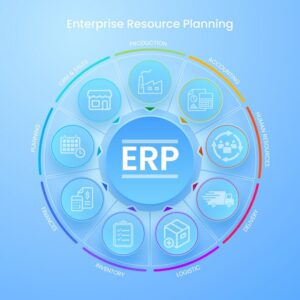 ERP (Enterprise Resource Planning) software is a comprehensive suite of integrated business applications designed to automate and streamline core business processes and functions across an organization. ERP software facilitates the flow of information and data between different departments, enabling seamless coordination and collaboration to improve efficiency, productivity, and decision-making. Here’s an overview of ERP software:
ERP (Enterprise Resource Planning) software is a comprehensive suite of integrated business applications designed to automate and streamline core business processes and functions across an organization. ERP software facilitates the flow of information and data between different departments, enabling seamless coordination and collaboration to improve efficiency, productivity, and decision-making. Here’s an overview of ERP software:
- Modules and Functionality:
- Finance and Accounting: ERP systems include modules for managing financial transactions, accounts payable and receivable, general ledger, budgeting, fixed assets, and financial reporting.
- Supply Chain Management (SCM): ERP software helps organizations optimize supply chain processes, including procurement, inventory management, demand forecasting, order fulfillment, logistics, and supplier management.
- Manufacturing and Production: ERP systems support manufacturing operations with modules for production planning, scheduling, resource allocation, shop floor control, quality management, and product lifecycle management (PLM).
- Human Resources (HR): ERP software includes HR modules for managing employee data, payroll, benefits administration, time and attendance tracking, performance management, recruitment, and talent management.
- Customer Relationship Management (CRM): ERP systems offer CRM functionality for managing customer interactions, sales pipelines, marketing campaigns, lead tracking, customer service, and support.
- Project Management: ERP software may include project management modules for planning, scheduling, budgeting, resource allocation, task tracking, and project collaboration.
- Business Intelligence (BI): Some ERP systems include BI and analytics tools for generating reports, dashboards, and data visualizations to analyze key performance indicators (KPIs) and support data-driven decision-making.
- Asset Management: ERP software helps organizations track and manage physical assets, equipment, facilities, maintenance schedules, and asset lifecycle management.
- Integration and Centralization:
- ERP software integrates data and processes from various departments and business functions into a centralized database or repository, providing a unified view of the organization’s operations.
- Integration enables seamless communication and data sharing between different modules and departments, eliminating silos, redundancies, and inconsistencies in data.
- Centralization of data and processes improves visibility, transparency, and accessibility of information across the organization, enabling better decision-making and collaboration.
- Customization and Configuration:
- ERP systems offer customization and configuration options to adapt the software to the specific needs and requirements of different industries, organizations, and business processes.
- Customization may involve modifying workflows, data fields, user interfaces, reports, and business rules to align with unique business processes and preferences.
- Configuration involves setting up parameters, options, and settings within the ERP software to tailor it to the organization’s business requirements without modifying the underlying code.
- Deployment Options:
- ERP software can be deployed on-premises, where the software is installed and managed on the organization’s servers and infrastructure.
- Alternatively, ERP systems are increasingly available as cloud-based (Software-as-a-Service or SaaS) solutions, hosted and managed by the ERP vendor or a third-party provider, offering scalability, flexibility, and accessibility from anywhere with an internet connection.
- Hybrid deployment models combine on-premises and cloud-based components to leverage the benefits of both approaches, allowing organizations to maintain control over sensitive data while taking advantage of cloud scalability and mobility.
- Benefits:
- Improved Efficiency and Productivity: ERP software automates repetitive tasks, streamlines workflows, and eliminates manual processes, reducing errors and increasing operational efficiency.
- Enhanced Visibility and Decision-making: ERP systems provide real-time access to integrated data and insights across the organization, enabling informed decision-making, forecasting, and planning.
- Cost Reduction and Resource Optimization: ERP software helps organizations optimize resource allocation, reduce inventory carrying costs, minimize waste, and streamline operations, leading to cost savings and improved profitability.
- Better Customer Satisfaction: ERP systems enable organizations to deliver faster response times, improved service quality, and personalized experiences to customers by integrating sales, marketing, and customer service processes.
- Regulatory Compliance and Risk Management: ERP software helps organizations maintain compliance with regulatory requirements, industry standards, and data security regulations by enforcing controls, audits, and security measures.
- Scalability and Growth: ERP systems are scalable and adaptable to support the evolving needs of growing organizations, enabling expansion into new markets, business lines, and geographies.
- Challenges and Considerations:
- ERP Implementation: ERP implementation requires careful planning, resources, and stakeholder buy-in, as well as considerations for data migration, system integration, training, and change management.
- Cost and ROI: ERP projects can be costly and time-consuming, with considerations for licensing fees, implementation costs, ongoing maintenance, and support. Organizations should assess the expected return on investment (ROI) and total cost of ownership (TCO) before selecting an ERP solution.
- User Adoption: Successful ERP adoption depends on user acceptance, training, and support. Organizations should prioritize user involvement, communication, and training to ensure successful implementation and user adoption.
- System Integration: ERP systems often need to integrate with existing systems, applications, and third-party solutions, requiring careful planning, data mapping, and integration strategies to ensure seamless interoperability.
Security and Data Privacy: ERP software handles sensitive business data and information, requiring robust security measures, access controls, encryption, and compliance with data privacy regulations to protect against cyber threats and unauthorized access.
Application Of ERP Software:
- Financial Management: ERP software provides modules for financial management, including general ledger, accounts payable, accounts receivable, budgeting, and financial reporting.
SAS offers solutions for financial analytics and performance management that complement ERP systems by providing advanced financial analysis, forecasting, and reporting capabilities. - Supply Chain Management (SCM): ERP systems include modules for supply chain management to optimize inventory management, procurement, order fulfillment, and logistics.SAS supports SCM through its analytics and optimization so
 lutions, which help organizations optimize supply chain processes, forecast demand, reduce costs, and improve overall supply chain efficiency.
lutions, which help organizations optimize supply chain processes, forecast demand, reduce costs, and improve overall supply chain efficiency. - Human Resource Management (HRM): ERP software includes modules for human resource management, including payroll, benefits administration, workforce management, and talent acquisition.SAS offers solutions for HR analytics and workforce optimization that complement ERP systems by providing insights into workforce trends, performance, and productivity, enabling organizations to make data-driven HR decisions.
- Manufacturing and Production: ERP systems include modules for manufacturing and production management, such as production planning, scheduling, quality control, and shop floor management.SAS supports manufacturing analytics through its advanced analytics and optimization solutions, which help organizations improve production efficiency, quality, and yield by analyzing manufacturing data and identifying opportunities for process optimization.
- Customer Relationship Management (CRM): ERP software often includes modules for CRM to manage customer interactions, sales, marketing, and service.SAS offers solutions for customer analytics and marketing optimization that complement ERP systems by providing insights into customer behavior, preferences, and buying patterns, enabling organizations to personalize marketing campaigns, improve customer satisfaction, and increase sales.
- Data Integration and Analytics: ERP systems generate vast amounts of data from various business processes, transactions, and interactions.SAS supports ERP systems by providing data integration, analytics, and reporting capabilities that enable organizations to extract insights from ERP data, uncover trends, and make informed business decisions based on real-time information.
- Compliance and Risk Management: ERP software helps organizations comply with regulatory requirements and manage risks associated with financial reporting, data security, and operational processes. SAS offers solutions for risk management, compliance analytics, and fraud detection that complement ERP systems by providing tools for risk assessment, monitoring, and mitigation, helping organizations identify and address compliance issues and fraud risks proactively.
